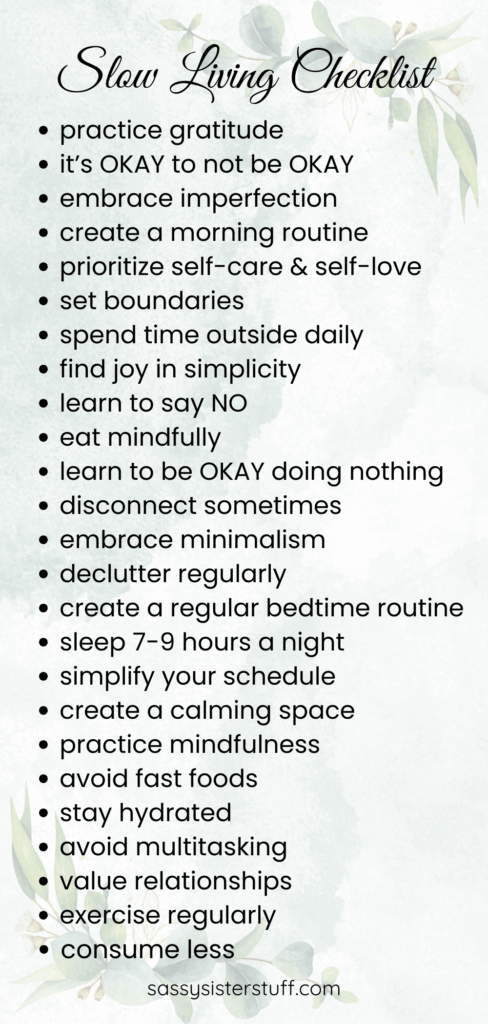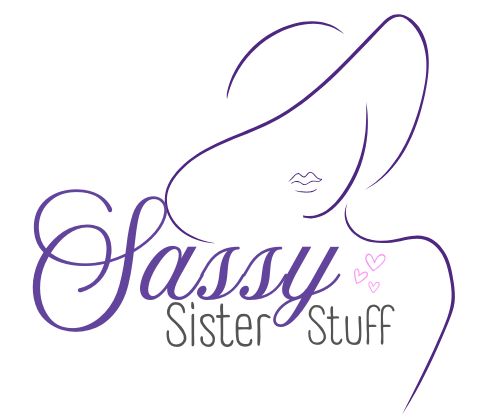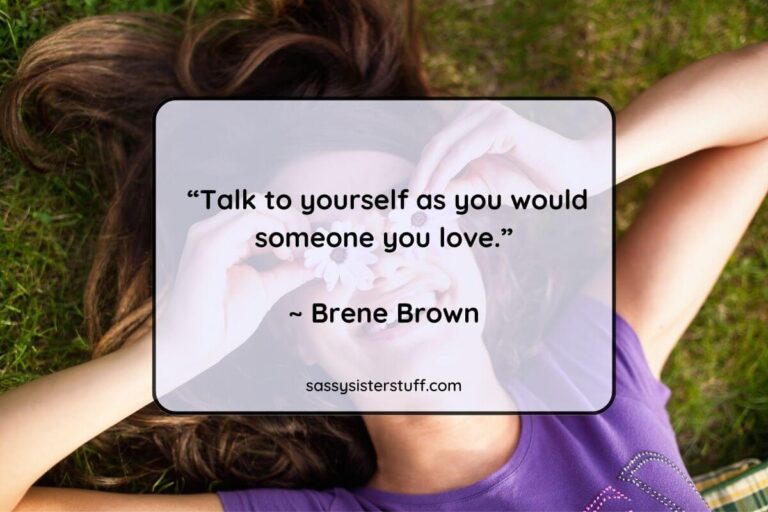What is Slow Living? 7 Principles to Simplify Life & Create More Joy
Life can be terribly chaotic and it’s easy to get caught up in the go, go, go lifestyle where you forget how to slow down. Your mind, body, and soul get in the habit of always being active — possibly even hyper. And it becomes a never-ending cycle of a busy, fast-paced life.
Unfortunately, this craziness can happen in all stages of life. So we need to learn the art of slowing down and living a calmer, more peaceful life — also known as slow living.
Some call it a slow lifestyle. Still others call it the unbusy movement. But you’re probably getting the idea! So we are going to explore the slow living movement and learn how it can help you live your best life with intention, balance, and connection.

Key Takeaways
- The slow living movement focuses on slowing down and finding joy in life’s simple pleasures.
- Slow living encourages you to be fully present in the moment, savoring experiences and paying attention to the details of daily life.
- The slow living movement advocates for decluttering both physical and mental spaces, focusing on meaningful relationships, and prioritizing activities that align with personal values.
- Slow living involves making intentional choices that prioritize quality over quantity, reducing waste, and embracing practices that have a positive impact on the world.
What is the Slow Living Movement?
The basic message of the slow living movement is to take a slower, more meaningful approach to life every day. People are striving to live a more simple and sustainable life with a focus on valuable relationships and peace of mind. They are finding joy in life’s simple pleasures.
A slow living lifestyle isn’t for any one particular population of people. It is a mindset that can be implemented by anyone who has a desire to live a slower, simpler life. It isn’t only for retired people who have a cozy cottage on the shoreline of the Chesapeake Bay. You just need to slow down your mind and make it a habit to live a simple life and be happy.

Slow living is sometimes referred to as an unbusy lifestyle. It’s a reflection of you doing your own thing, in your own time, at your own pace. It is taking time to completely immerse yourself in the simple things around you that bring your joy. It’s about decluttering your lifestyle — think of a minimalist lifestyle.
You’ve most likely heard the phrase, “It is okay to not be okay.” Similarly, “It is okay to not be busy.” For a very long time, it seemed a busy lifestyle was a badge of honor — but for those who choose to live a slow lifestyle, we celebrate taking your foot off the accelerator.
Slow living is a way to connect with your surroundings and take time out of life for a peaceful existence. It is about slowing down and taking care of yourself. Sometimes, it’s as simple as not wearing a watch for a day or two, or going a few days without your cell phone. It’s a simple mindset of slowing down.
Life in the slow lane can be delightful!

Origin of the Slow Living Movement
According to Wikipedia, the slow living movement began in Italy with the slow food movement, which emphasized traditional and cultural foods, as well as food-prep techniques, over the emergence of fast foods in the 1980s and 1990s.
Activists demonstrated against building a McDonalds near the steps of the Spanish Steps in Rome. They even wrote a manifesto that ultimately inspired the slow living movement around the world.
Some slow living advocates use SLOW as an acronym for four major issues represented by the slow living movement: S: sustainability (using materials that have a limited impact on the world); L: local (using materials and products that are produces locally); O: organic (avoiding products that have been mass-produced or genetically altered); W: whole (avoiding processed foods or materials).
Slow living suggests that you should enjoy life more, and you can do this by slowing down to avoid a chaotic life. You should live in the present moment and enjoy the sensory joys around you.
However, it should be noted that the slow living movement does not suggest limitations on the growth of the Internet, technology, mobile phones, and other such advancements.
Over the years, the slow living movement has taken on many different names in various locations around the world. The movement has also been adapted to include all areas of life rather than just slow food.
It has been called simple living, slow movement, unbusy living, balanced living, intentional living, connected living, mindfulness, living with purpose, and other names.
Leaders in the slow living movement include: 1) Author and Podcaster, Brooke McAlary; 2) Author and Speaker, Carl Honore; 3) Life Coach and Podcaster, Rachelle Glendon. They offer a number of books, podcasts, blogs, vlogs, and TED talks about living a slower lifestyle.
Additionally, the founder of the International Slow Food Movement in Italy, Carlo Petrini, continues to be an advocate for slow living after he led the 1986 demonstrations against McDonalds.
The slow living movement today focuses on simplicity, minimalism, mindfulness, sustainability — an overall slower lifestyle — a set of values that believes faster isn’t always better.

Slow Living Principles
The 7 principles of slow living equate to living better at both work or home. The principles support the importance of self-care every day and doing more of what you enjoy — while living an honest, clean life.
Although you can find a variety of slow living principles on the Internet, I’ve collected and consolidated seven principles here so you can see the overall picture of what it’s like to live a slow lifestyle in accordance with the slow living movement.
1. A Slow Approach to Every Day Life
In today’s society, we are constantly being pushed to work harder and move faster. Whether it be from the pressures from our jobs, from school, or even from our own social lives, it can feel as if there is never enough time in the day to do every thing.
While this approach may work for some people, others may find themselves drained and lacking a sense of accomplishment. It can quickly become very overwhelming!
So the slow living movement recommends that you make a lifestyle change that involves simplifying your life, and changing your mindset. Stop over-scheduling your calendar… stop thinking you need to be on the go all the time… stop saying YES to every thing… and take a slower approach to every day life.
Create a life where you can delight in your every day routine — a routine that gives you pleasure and brings you contentment in your soul. Create a routine where you wake up happy to face each day; establish routines throughout your day that give you time for rest and relaxation; and develop evening routines that help you settle into sleep with peace of mind that you have lived well!
2. Live with Mindfulness and Presence
Is it possible to live every day with mindfulness and presence? Absolutely! It doesn’t matter what you do, but if you can be fully present in each moment of your life every day, you’ll find that life becomes simpler, more satisfying, and less stressful. The key is making a conscious effort to live more mindfully and in the present moment.
In this world of technology and the barrage of information you are faced with daily, it is easy to live a life of distraction and chaos. You can become so overwhelmed that you forget to be mindful of the present moment.
In order to combat this, many people turn to mindfulness and meditation as a way to break out of the chaotic cycle and start living a simpler, more meaningful life. You may want to consider meditation or other ways to break out of the chaos.
Delight in the here and now and what’s in front of you. This is a simple mindset habit that will help you move toward slow living and simplifying your life. Don’t worry about the past or the future. Focus on what’s happening in your life right now — in this moment.

3. A Connection to Community
As the old saying goes, “slow and steady wins the race.” There are many ways to live life with less stress and more mindfulness. Slow living is an approach to life that focuses on one’s current activities in their present moment.
Take time to connect to your community by volunteering or organizing a local event for people in your area. This kind of activity, and the connections you make, help you feel more connected and peaceful.
Slow living is a philosophy that involves slowing down and having a positive connection to your community. There are many aspects of this lifestyle, but the main idea is to take time for self-reflection and to resist the fast-paced world of today. Slowing down will help you become more mindful of what you take into your soul and how it affects your life.
Delight in the activities available in your community. This can be a place of safety and enjoyment. There are generally people who are much like you — people you may have something in common with. You may find wonderful, meaningful connections that become an important component of your life. This is part of the slow living movement.

4. A Commitment to Living with Purpose
Every morning I wake up with the intention of living a purposeful life. Sometimes this is not an easy task, but it is important. In order to be happy, you must have a purpose in life and embrace your passions.
There are various ways in which you can live with purpose. For example, you may work to better yourself personally or professionally, or help others in need, or serve your community in some manner.
Although it may seem intimidating at first, living with purpose is much easier when you commit to figuring out what you want in life and go out into the world to find it. Ask yourself what you enjoy, what are you passionate about, and what does your soul crave? What can you do to feel fulfilled? Do you have a special interest that gives you a sense of purpose?
If you are living a slow lifestyle, one thing that should be included in your routine is a favorite hobby or special interest. A hobby or special interest gives you pleasure and helps your personal growth. It helps you connect with others, and gives you purpose and satisfaction.
Delight in a hobby or special interest that gives you purpose. It supports your slow living lifestyle by developing your sense of value while also offering you a regular time for relaxation.

5. A Commitment to Minimalization and Consuming Less
Minimalism is the practice of living with only the items that are necessary for a minimalist lifestyle. A slow living lifestyle includes a commitment to minimalism and consuming less by decluttering your home, culling your wardrobe, and curbing your spending. These behaviors promote simplicity.
An increasing number of people are becoming minimalists to help them consume less and live a simpler, more fulfilling life. What is the reason behind this trend? It’s because a society that values material possessions can sometimes lead to unhappiness, or emptiness. Becoming a minimalist can help people stay debt-free and live on less money by only buying what they need without wasting money on unneeded items.
Additionally, overconsumption is one of the main causes of environmental problems. But many people don’t realize that they can make changes in their own lives to make a difference in the world. The goal is simply to consume less — which means having less stuff, spending less money, using fewer natural resources, and producing less waste.
Delight in a simplistic mindset and minimalist behaviors that support a slow living lifestyle. You’ll be helping yourself and the world around you!

6. Value Relationships and Social Connections
Does the way you spend your time reflect the relationships and social connections that are most important to you? For many, it would seem that they are more focused on their technology devices than interacting with the people in their lives.
One study found that around 90% of people checking social media will pick up their phone during a one-on-one conversation, and 66% of these people will take out their phones during a meal. Yikes! (I might be guilty of this on occasion!)
As we live in an era of rapidly changing social norms, people are finding it more difficult to maintain close relationships. With the growth of technology and the expansion of social networks, it has become easy to spend time with people online rather than in person.
This can lead to less contact with real life friends with whom you share similar interests and values, which weakens authentic relationships. Although there are benefits to broadening one’s horizon via technology, it is important to maintain strong ties with those who share your values and interests in life. This is why it is important to value relationships and in-person social connections.
Delight in creating, maintaining, and valuing space in your life for authentic relationships and social connections that truly lift and empower your soul. Don’t allow technology to misdirect, complicate, or confuse your mindset or behaviors.
Pin to Pinterest for Later
7. A Promise to Slow Down
People often tell themselves and others that they’ll slow down once they reach a certain age. The age can vary, but the underlying message is usually that we should be more relaxed and less demanding of ourselves in old age. However, there’s a growing sentiment among people that we should slow down now, not later.
But it is difficult to slow down when life is in full swing. After all, there are so many things that need doing — work, laundry, health, family. All of these responsibilities provide good excuses for why it is necessary to keep moving at an accelerated pace.
What most people forget about the race is that it will eventually run out. The question then becomes how much can be accomplished with the limited amount of time left? And how do you want to spend your race?
Most people do not want to spend their lives in chaos. Once they take time to learn and reflect on their options, they choose a life of peace and joy over the chaos. But it takes a commitment to slow down and make changes as we’ve discussed in this article.
Delight in what’s genuine and real. Don’t allow the chaos of life to disrupt your slow lifestyle or your commitment to peace, happiness, and calm.

Slow Living Benefits
Slow living is a way of life that doesn’t just mean slowing down — it also means leading a more balanced life. It entails avoiding the rat race, staying present in the moment, and savoring activities that you enjoy.
Slow living is good for the body, mind, and soul. It can improve your mood and sleep pattern while simultaneously reducing stress levels which can lead to better physical health. Consider these valuable slow living benefits:
- You don’t have to worry about keeping up with anybody.
- Your true values are at the heart of your lifestyle.
- You are more self-aware and make decisions with intention.
- You focus on what matters most in life, like people and relationships.
- Your health and wellbeing become more important (and you have more time for self-care).
- You can savor life’s most precious gift — TIME.
- No more feelings of being over-worked, over-stimulated, over-scheduled, or overwhelmed.
- You replace chaos with contentment.
- Your life becomes more meaningful.
- You live with an attitude of gratitude that helps you feel more joy.
- Your stress and anxiety melts away.
- You can boost your creativity and productivity.
Slow living is a lifestyle choice that challenges your pace of life and promotes mindful living. Simply put, slow living advocates for slowing down and enjoying what you have right now instead of trying to gain more and more by over-working and over-scheduling. There are many benefits to this way of life.

The Art of Slow Living
Slow living might conjure up an image of a boring life. In fact, it’s just the opposite. Slow living is the art of enriching your life with the natural beauty around you and choosing to live a more balanced, meaningful life.
You slow down and appreciate the world around you and what you have in life. This gives you more time for self care, prioritizing things, relationships, and even breathing.
We have become a society where more is better... newer is better… busier is better… faster is better. We’ve become a society of social validation where the newest iPhone is a sign of success — or the long-awaited pair of athletic sneakers is a sign of wealth — or being incessantly busy is a sign of popularity.
But are these THINGS really important in life? There isn’t one universal definition for slow living, but I think there are words we can all associate with the concept — words that are more important in life than more, newer, busier, and faster. Let’s think about these words instead and how they make us feel:
- cozy
- simple
- calm
- warm
- harmony
- joy
- seasonal
- connections
- smiles
- slow
- happy
- snuggles
- casual
- relaxed
- comfortable
- protected
- traditional
- tasty
- creative
- pleasures
- nature
- beauty
- blessings
- gratitude
- positive
- peace
- quiet
These are words associated with the slow living movement… for me, they are also words that bring me comfort. These words give me a feeling that I want to have in life — so maybe slow living is where I need to be! What about YOU?

Are You Ready for Lifestyle Changes?
Given the fast pace of modern life in today’s world, are you ready to explore the many benefits of slow living for yourself and your family?
The hustle culture and desire for instant gratification can really wear on your mental health. It’s time to explore a more leisurely pace of life with enough free time to actually take a deep breath of fresh air in our natural world.
Slow living means you’ll learn to value the important things in your daily life and appreciate simple ways to find happiness. You’ll be able to grab a cup of coffee and move at a snail’s pace if you so choose.
You’ll teach your family how to lay down their cell phones, avoid fast food, and re-examine their personal values. They will learn the value of making their own food that’s healthy and delicious with local ingredients.
Speedy driving, long hours, and a fast life will become a thing of the past. Slow fashion, slow travel, a slow heart rate, and a slower-paced life will become your new normal.
Making these lifestyle changes will be a great personal development project for you and the members of your family.
A SLOW LIVING CHECKLIST JUST FOR YOU!

Slow Living Quotes
Intentionally slowing down will help you lessen the pressures of life and teach you skills to appreciate simple things — whether it’s gratitude for your family, being present in the sunshine, or just connecting with a friend for brunch. Use these slow living quotes to inspire your mindset change and slow down your life.
“Being Slow means that you control the rhythms of your own life. You decide how fast you have to go in any given context. If today I want to go fast, I go fast; if tomorrow I want to go slow, I go slow. What we are fighting for is the right to determine our own tempos.”
~ Carlo Petrini
“Slow living provides an opportunity to step back, pay attention, and question the ways we use technology, to recalibrate our relationship with the constantly switched-on, logged-in world.”
~ Brooke McAlary
“It takes courage to say yes to rest and play in a culture where exhaustion is seen as a status symbol.”
~ Brene Brown
“Slow down. Find peace in little moments. Learn what you love, fill your life with it, and watch yourself come alive.”
~ Sonya Matejko
“Adopt the pace of nature. Her secret is patience.”
~ Ralph Waldo Emerson
“The slow philosophy is not about doing everything in tortoise mode. It’s less about the speed and more about investing the right amount of time and attention in the problem so you solve it.”
~ Carl Honore
“The older I get the more I realize I just need the simple things in life: a comfy home, good food on the table, and to be surrounded by people I love.”
~ Rachelle Glendon
“Slow Living means structuring your life around meaning and fulfillment. Similar to ‘voluntary simplicity‘ and ‘downshifting,’ it emphasizes a less-is-more approach, focusing on the quality of your life…Slow Living addresses the desire to lead a more balanced life and to pursue a more holistic sense of well-being in the fullest sense of the word. In addition to the personal advantages, there are potential environmental benefits as well. When we slow down, we often use fewer resources and produce less waste, both of which have a lighter impact on the earth.”
~ Beth Meredith and Eric Storm

Summary of the Slow Living Movement
— Slow living refers to a lifestyle that encourages a slower approach to aspects of everyday life. It is living life at a relaxed or leisurely pace. I think of it as a simple, slower mindset and a slower pace of life.
— Slow living is a revolutionary way to enjoy life. It involves living in the present moment without regret, embracing the experience of every moment, focusing on what is essential, and finding joy in simplicity.
— Slow living can be done in any type of neighborhood or home, but it won’t work unless you’re committed to slowing down — body, mind, and soul — in your personal life and at work.
— Slow living is the idea that you should take your time with everything you do. It’s not about being lazy, it’s about taking your time to live life. It’s about taking deep breaths to reset your mind and body; and enjoying the little things in life.
If you are part of the Slow Living Movement, I would love to hear about it! I have been trying to slow down and live a more mindful lifestyle — some days are easier than others — but I do NOT feel the need to be busy all the time anymore. This is significant progress!
You Will Love these Related Articles:
- What is Living Aware? The Benefits of Conscious Living – This article complements the principles of slow living by cultivating a greater sense of mindfulness and awareness in your life.
- How To Bring More Cozy Into Your Life with Hygge – This article explains the hygge lifestyle from Denmark and helps the reader understand how to create a more cozy lifestyle.
Love to ALL! ~ Susan







